Ink
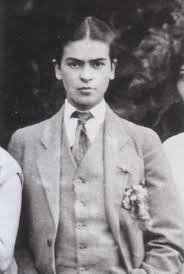
(Artist Frita Kahlo as a young woman in gentleman’s attire.)
Rafael works his ass off. If you took his duties behind the bar at Willow as a full time job, he adds another as a pastry chef after the restaurant closes down at night, making the most extraordinary filled doughnuts.
I have always liked him: he is upbeat to a fault, wears shorts even in the savage winter, and has a curious alternate mode of shaving his head while growing a neatly trimmed beard, or letting his hair come back and going clean-shaven. He can turn himself literally upside down that way, and as a Coast Guard veteran, also knows how to square himself away.
Anyway, the other evening at Willow I was sitting next to Old Jim at the Amen Corner and Raf was behind the bar looking a little rueful, rubbing the left sleeve of his black shirt. I asked him if he was OK, and he responded that a new tattoo was still healing.
Naturally, I was interested in the new ink. Jasper is always enhancing the amount and quality of the designs etched on his body, as many of the young people in the wait staff have. Jasper’s theme is sort of Oriental in nature, which is natural, considering he is from Guam, and I asked if we could see Raf’s new work.
He grimaced a bit, and then unbuttoned the cuff of his sleeve and gingerly rolled up the black sleeve.
“Holy crap!” I said, when the image was revealed. “That is fantastic!”
What he had done was have a black-and-white image of what appeared to be a young man in a tie imposed on his left forearm that extended to a magnificent crimson rose, which at the moment was augmented by a crust of scab and dried blood.
“Who is it?”
“Mexican artist Frita Kahlo,” he said proudly.
“I thought she had that mono-brow thing going. I know her self portrtatis.”
“That is mostly what she did,” said Raf. “She had health problems all her life, and her face was something she could always look at in the mirror.”
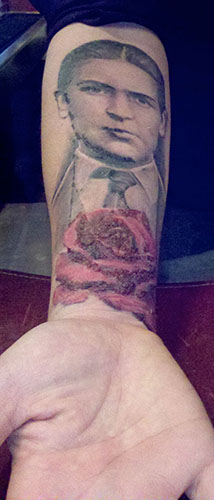
“That is incredible detail- how long did it take to get it?”
“Eight hours. We had to quit while we were on the rose. It just was taking too long.”
“Why Frita? You know she lived in Detroit in the 1930s when her husband Diego Rivera was painting those murals at the Institute of Arts on Woodward.”
Raf smiled. “I always liked her work. It is vibrant and iconic and it resonates for me.”
“They would probably save the city’s finances if they could sell those murals,” mused Jim. “Kind of ironic that Henry Ford the capitalist paid communist Diego Rivera to paint a tribute to the value of labor.”
“He paid more than the average wage to get good workers,” I said. “Detroit was an amazing place in its time. And Henry was a good guy for a vicious capitalist anti-Semite.”
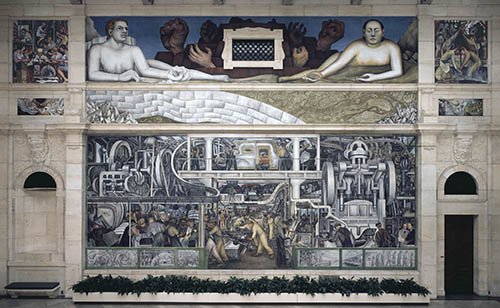
Raf shrugged, rolling down the shirt sleeve with a grimace where the cuff touched the oozing rose. “I was hoping to get it done in time for the Tattoo convention in Baltimore, but this won’t be healed in time.” he brightened at the thought. “That means I can get the whole sleeve done for the next one,” he said drawing his finger up the side of his bicep.
“I guess it is appropriate. You were a sailor, after all. What is the rest of the sleeve going to look like? More frita, or would you consider the images from the Rivera mural?”
Raf laughed and picked up a load of black napkins. “I don’t know yet. You have to have the vision.” He moved off down the bar. I looked over at Jim.
“That is incredible work. Can you imagine sitting still for eight hours while getting punched with a needle?”
“Frankly, no,” he growled, taking a pull of Budweiser. “I have no idea what this generation thinks things are going to look like when they are my age.”
“They may droop, but they will be colorful, Jim. I wonder what my next one should be. If Rafael doesn’t do the Detroit Institute of Arts, maybe I will get something from that. Find out who Raf’s artist is. That is talent.”
“You ought to just get a tramp stamp on your ass and leave it at that,’ said Jim.
“I am sort of sympathetic to that idea. But of the many things I am, I am not easy.”
“I didn’t say you were easy,” said Jim. “In fact, quite the contrary.”
“Thanks,” I said. “I will consider it, though I was thinking about a “ΜΟΛΩΝ ΛΑΒΕ!” on the right biceps.”
“If you tell them to come and get it, what the hell happens when they do?”
“Touche, Sir.” Then I waved my un-inked arm in the air, and Jasper headed down the bar toward us with the bottle of Happy Hour chardonnay.

Copyright 2014 Vic Socotra
www.vicsocotra.com
Twitter: @jayare303
Kido Butai
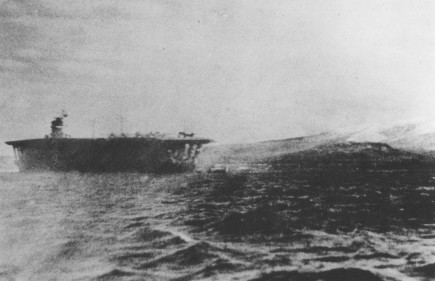
(IJN Akagi maneuvering, 1941)
Sorry, this is late and I am still processing The Dream. I ought to be getting my butt in gear and doing something productive.
I am not much for interpretation of these night-time things, and normally do not recall much about the dreams I am sure I have all the time. The ones I recall are the ones that wake you with heart pounding Technicolor aspects that stay with me for a while. You know, the ones with doom that builds into some Zombie Apocalypse with a lot of running and the certainty that it will not end well.
I don’t think I die in those, though I am sure when ZA comes around I will.
This was something different. I have some pals who understand spirit journeys and shamanism, and I am sympathetic to sincere beliefs. After the way Raven and Big Mama took their leave, I have decided not to rule anything out.
So, skeptic that I am, I do not know what to make of this dream. I have been having a weird sleep cycle and there has been a lot on my mind to process during REM sleep- relationships and retirement and money.
So, I was having a particularly realistic journey across the dreamscape as the alarm clock was heading toward 0230. It was quite striking. It had no zombies, no running, or falling. No nightmarish aspects at all, in fact. It was just a matter-of-fact adventure in national security and time travel.
I was talking to some of the people I used to work with, lining out The Mission, which involved an insertion into another time and space. The fabric of some of the places we worked- bunkers, gates, concrete motif- was both dramatic and completely familiar. It looked a little like the tunnel at Field Station Kunia, up in the pineapple fields near Wahiawa in central O’ahu.
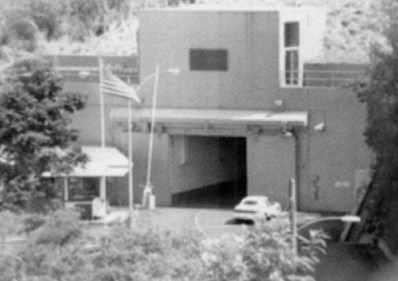
(Portal to the Field Station Kunia)
Walking out of the bunker, I found myself in a seat in a prop aircraft droning through crystalline skies towards a big ship with a straight deck. I felt the play for the deck, and the cut pass, something the jets do not do in today’s aircraft carrier navy. The jets hit the deck at full power just in case a hook-skip results in a “bolter,” and the need for speed to get off the deck and take the airplane around again.
Not this one- the invisible pilot chopped the power and down we came, snagging the wire and surging forward into the straps.
I realized we had flown- presumably from a field in Hawaii- to the Kida Butai, the First Air Fleet striking arm of the Imperial Japanese Navy that was about to attack Pearl Harbor.
The feel of the carrier was familiar, even if the ship was not. Straight deck with pillars to support it, fore and aft. Akagi, I wondered? I was not exactly a prisoner, and not exactly a guest. A large and imposing Japanese officer came to the stateroom where I was being held with a female comrade, an officer who I now cannot identify (Alice, my deputy at 3rd Fleet?) as the dream ended and some of the details are fleeing with consciousness and caffeine.
But the conversation that occurred in the stateroom was vivid then and is vivid now. The imposing and somewhat rumpled officer was striking, and I had been warned of his size. He asked me why I was there, an American at this time.
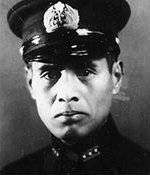
(CDR Minaru Genda, First Air Fleet)
I said: “The past cannot be changed but I need to be a witness.”
He nodded, thoughtfully, as though that was the most natural thing. He asked what was going to happen the next day. I told him his forces would achieve near total surprise, and they would destroy all of the battleships in the harbor. He smiled and then said, “what will happen after that?”
I said: “You will lose your freedom, your life and your country.”
I then woke in the darkness. The time displayed on the clock on the side-table glowed that awkward time: too early to rise, too late to get back down. And the dream was so vivid, as though I had stepped into one of Mac’s stories of that time long ago.
I finally gave up and got up. I looked on the computer to see if there were any remarkably large or rumbled officers in the Kido Butai, but those are hardly decent search terms.
Admiral Yamamoto, whose English was quite good, did not fit the bill, though our pal Mac was involved in planning the ambush that killed him.
I sipped coffee and looked out the dining room window into the single-digit darkness of the start winter. So, why would the dead want to approach me?
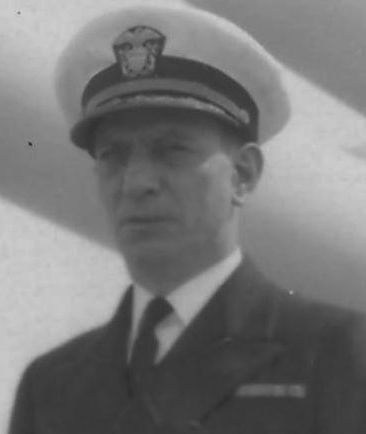
(CAPT Charles Hamilton Maddox)
I have an interesting relationship with a woman who is on a quest to find out what happened to her grandfather, CAPT Charles Hamilton Maddox, academy grad, radio specialist, and head of the British Empire Section at the office of Naval Intelligence.
On that real morning after I talked to the dream Japanese officer on the ghost ship, CAPT Maddox was Senior Officer Present Afloat (SOPA) and directed USS Ward (DD-139) to engage the Empire of the Sun, hitting a mini-sub attempting to enter the harbor’s submarine defenses by shadowing an American supply ship.
That was hours before the wave of Kates and Vals showed up over the harbor to savage the sleeping battleships.
Her quest enabled her to travel and hire investigators and she had a remarkable number of Pearl Harbor Survivors as correspondents, Mac included. They are just about all gone now, certainly the senior officers who might shed light on what happened even at this distance. There are some holes in the story.
We talked a while ago, trying to unravel some of the many mysteries, so maybe that is why the dream percolated to the surface- but it was weird, and unlike any dream I can recall.
As usual, I felt the need to talk to Mac about it. Unfortunately, the only way I can do that is in dreamland.
Weird.
Copyright 2014 Vic Socotra
www.vicsocotra.com
Twitter: @jayare303
SOTU

I had every intent of watching the SOTU last night- I view it a duty of an informed citizen to know what sort of nonsense our rulers are spewing at any given moment. I was willing to even watch the rebuttal afterward, just to see what the inverse of the President’s opinions might be, not having any of my own.
Oh, sorry, almost forgot the disclaimer: I tend to have more contempt for the party that is actually in power at any given time than the other one, since it is more of a direct threat to our liberty. Please don’t take this as anything but mild dyspepsia for the process as it exists today of this astonishing experiment in representative government.
I am not confident about the state of the union, not that I am responsible for it, but I certainly think it seems a little threadbare in places. We are not talking to each other any more. I look through the “comments” section after some of the articles I read about politics, and between the Trolls and the True Believers it seems we are just yelling at one another.
Still, one has an obligation to stay informed. I got back from Willow in time to watch, and was considering which biased news source to have the President’s remarks filtered through. I ticked off the usual suspects, and decided that C-SPAN would be the least irritating.
It was a chill evening after a cold day. Willow had been rocking after a quiet Monday- maybe it was a function of apprehension about the possibility of more snow.
Fish and Wildlife was out in force, desperately partying at a classy place against the inevitability of the Service’s forced move to Seven Corners later in the year in the interest of cost savings. There they will have a Chilis as the nearest watering hole, or maybe the Olive Garden, which is a daunting prospect.
I was enjoying a long-deferred catch-up with former colleagues from the Phone Company. One of them is married to a politician who chairs a major committee on the Hill, and the other was my old Boss who in addition to a demanding day job is in the arduous process of becoming a Deacon of the Catholic Church.
Both amazing people. The Political Wife had to take off to attend the SOTU address in person. I marveled at the idea of physically being in the crowd with all those people.
But I won’t go down that rabbit hole- Old Jim was taking a pass on the bar that night due to the extreme cold conditions, and the possibility that there would be snow on the ground that could land him on his head or worse in the walk down the block.
I mixed an el Guapo vodka tonic upon a safe return with no accumulation of snow on the ground, and turned on Fox News to settle in for the President’s remarks. He entered the chamber- I looked to see if I could see my friend among the aggregation of the greats and ingrates in the crowd.
Speaker Boehner wasn’t as orange colored as he is usually, and he eventually gaveled the chamber into order and introduced the President, who began to read things off the teleprompter. I realized there was absolutely no way I could handle it and turned it off and went to bed. Snow was starting to scud across the patio outside. Enough.
This was the best summary I saw when I dragged my sorry ass out of bed this morning, from Jim Geraghty of the National Review: “In a development that surprised no one, the President’s fans liked it, his critics largely hated it, and millions upon millions of Americans wondered what happened to their favorite shows.”
Copyright 2014 Vic Socotra
www.vicsocotra.com
Twitter: @jayare303
The Cremation of Sam McGee
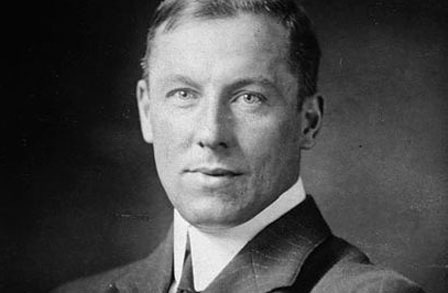
(Robert W. Service, January 16, 1874 – September 11, 1958).
Gentle Readers,
I have to be on the wrong side of the Potomac way too early, and the dog sled is not ready. Accordingly, I am not going to talk about how freaking cold it is out there, or the State of the Union address this evening, which apparently will include some mind boggling assertions on a variety of issues. I will not comment a priori- my pals are agitated in a variety of perfectly rational issues and I will be interested to see how it comes off.
Nor can I address the matter of the comments on Facebook regarding the photo collections of long ago. No time, but the comments are appreciated. Most were taken when Robert W. Service was still alive.
So, in the spirit of this very cold morning, I will ask an associate to stand in for the usual fulminations. His name is Robert W. Service, and the Englishman-turned-Canadian was quite the literary figure in his day. His fame resulted from the publication of two best-selling volumes of verse: The Spell of the Yukon (1907) and Ballad of a Cheechako(1909).
In rollicking rhythms and comical rhymes, Service regaled armchair adventures with gripping yarns of the wild Northwest—rough men braving hardship on the lonely frontier in pursuit of “the muck called gold.”
After his time in the Gold Rush he returned to Europe in time for the Balkan unpleasantness followed by the real horror of the Great War. Like Hemmingway, he was turned down for active service but went to the show anyway as a stretcher bearer.
In the 1930s, he visited the Soviet Union and penned a satiric piece called “The Ballad of Lenin’s Tomb,” which apparently is why none of his works have been translated into Russian. I may ask Natasha to look into that.
But despite the origin of his fame, Service chose to spend his declining years in southern California and Monte Carlo.
It strikes me that he was onto something about the value of commodities in uncertain times, but I am too cold to think about it this morning. Without further ado, here is a masterwork of temperature and doggerel:
There are strange things done in the midnight sun
By the men who moil for gold;
The Arctic trails have their secret tales
That would make your blood run cold;
The Northern Lights have seen queer sights,
But the queerest they ever did see
Was that night on the marge of Lake Lebarge
I cremated Sam McGee.
Now Sam McGee was from Tennessee, where the cotton blooms and blows.
Why he left his home in the South to roam ’round the Pole, God only knows.
He was always cold, but the land of gold seemed to hold him like a spell;
Though he’d often say in his homely way that “he’d sooner live in hell.”
On a Christmas Day we were mushing our way over the Dawson trail.
Talk of your cold! through the parka’s fold it stabbed like a driven nail.
If our eyes we’d close, then the lashes froze till sometimes we couldn’t see;
It wasn’t much fun, but the only one to whimper was Sam McGee.
And that very night, as we lay packed tight in our robes beneath the snow,
And the dogs were fed, and the stars o’erhead were dancing heel and toe,
He turned to me, and “Cap,” says he, “I’ll cash in this trip, I guess;
And if I do, I’m asking that you won’t refuse my last request.”
Well, he seemed so low that I couldn’t say no; then he says with a sort of moan:
“It’s the cursèd cold, and it’s got right hold till I’m chilled clean through to the bone.
Yet ’tain’t being dead—it’s my awful dread of the icy grave that pains;
So I want you to swear that, foul or fair, you’ll cremate my last remains.”
A pal’s last need is a thing to heed, so I swore I would not fail;
And we started on at the streak of dawn; but God! he looked ghastly pale.
He crouched on the sleigh, and he raved all day of his home in Tennessee;
And before nightfall a corpse was all that was left of Sam McGee.
There wasn’t a breath in that land of death, and I hurried, horror-driven,
With a corpse half hid that I couldn’t get rid, because of a promise given;
It was lashed to the sleigh, and it seemed to say: “You may tax your brawn and brains,
But you promised true, and it’s up to you to cremate those last remains.”
Now a promise made is a debt unpaid, and the trail has its own stern code.
In the days to come, though my lips were dumb, in my heart how I cursed that load.
In the long, long night, by the lone firelight, while the huskies, round in a ring,
Howled out their woes to the homeless snows— O God! how I loathed the thing.
And every day that quiet clay seemed to heavy and heavier grow;
And on I went, though the dogs were spent and the grub was getting low;
The trail was bad, and I felt half mad, but I swore I would not give in;
And I’d often sing to the hateful thing, and it hearkened with a grin.
Till I came to the marge of Lake Lebarge, and a derelict there lay;
It was jammed in the ice, but I saw in a trice it was called the “Alice May.”
And I looked at it, and I thought a bit, and I looked at my frozen chum;
Then “Here,” said I, with a sudden cry, “is my cre-ma-tor-eum.”
Some planks I tore from the cabin floor, and I lit the boiler fire;
Some coal I found that was lying around, and I heaped the fuel higher;
The flames just soared, and the furnace roared—such a blaze you seldom see;
And I burrowed a hole in the glowing coal, and I stuffed in Sam McGee.
Then I made a hike, for I didn’t like to hear him sizzle so;
And the heavens scowled, and the huskies howled, and the wind began to blow.
It was icy cold, but the hot sweat rolled down my cheeks, and I don’t know why;
And the greasy smoke in an inky cloak went streaking down the sky.
I do not know how long in the snow I wrestled with grisly fear;
But the stars came out and they danced about ere again I ventured near;
I was sick with dread, but I bravely said: “I’ll just take a peep inside.
I guess he’s cooked, and it’s time I looked”; … then the door I opened wide.
And there sat Sam, looking cool and calm, in the heart of the furnace roar;
And he wore a smile you could see a mile, and he said: “Please close that door.
It’s fine in here, but I greatly fear you’ll let in the cold and storm—
Since I left Plumtree, down in Tennessee, it’s the first time I’ve been warm.”
There are strange things done in the midnight sun
By the men who moil for gold;
The Arctic trails have their secret tales
That would make your blood run cold;
The Northern Lights have seen queer sights,
But the queerest they ever did see
Was that night on the marge of Lake Lebarge
I cremated Sam McGee.
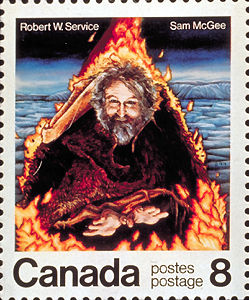
Copyright 2014 Vic Socotra
Poem courtesy estate of Robert W. Service
www.vicsocotra.com
Twitter: @jayare303
Deep Freezer
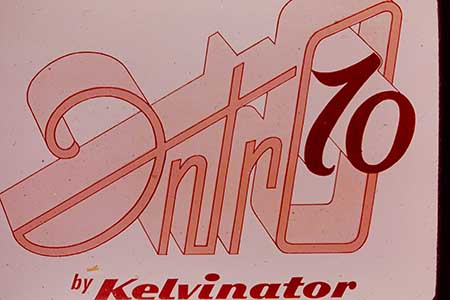
No, this is not going to be about the next Polar Vortex that may- or may not- be coming our way. Nor is it about the Serious Action to Protect the Planet that the President may- or may not- talk about in the State of the Union address tomorrow. I was looking at the thermometers outside the kitchen window this morning- 37, and the one nailed to the tree out by where I part the Panzer- 40- a discrepancy between side and front yards that is larger than the claimed temperature increase since the Industrial Revolution.
I will leave a discussion of all that stuff to peer-reviewed science, hahaha. I mean, who would have anticipated that simple observations of the weather would turn into jagged political arguments about the end of the world?
It hasn’t, or rather, it continues to change as it always has.
This was a weekend lost to memories of a half-century ago down on the farm. For those addicted to social media (I am not, I have too many devices and digital enclaves to try to keep up on as it is) there is a vigorous discussion of a couple hundred images I scanned Friday night, and have been struggling to edit ever since. Oh well, it is what it is.
The daunting stack of slide carousels in the garage at Refuge Farm continue to scold me. They are part of a information stream that is being marginalized with each new generation of technology. Like music. Wax discs to wire recorders, to reel to reel tapes to cassettes and then oblivion.
Same deal with the pictures. I got rid of the screen and slide projector when we closed out the house in the Little Village by the Bay, and the only way to view them is to convert to digital.
This weekend I have treated Facebook to thrilling accounts of a visit to West Webster, NY in the later 1950s. A trip Raven and Big Mama took to Bermuda in 1972 as a sort of homage to Grandfather Socotra, who installed the first telephone network on the island a century or more ago. That is worth a story- and speaking of which, there were moving pictures of Grandfather in his solar topee (pith helmet) returning to New Jersey by sea- but I doubt that there is a projector in the family left to show them.
Anyway, that is a long way around the Rose Bush to get to the Deep Freezer saga. This morning I posted a bunch of slides from Raven’s days at Kelvinator Appliances. A bit of background- Raven was recruited to join the American Motors Company out of Ford’s design shop. He worked for the legendary Ed Anderson, head of styling, who did all sorts of amazing things on a shoe string.
One of them was re-tooling the British-designed Metropolitan for George Romney before he sold the estate in Romeo, Michigan (“Skoal Acres”) and retired to Mexico. Ed was replaced as Head of Styling by the talented Dick Teague as George Romney left the company to settle into the long decline to run the State of Michigan and be destroyed in his bid for the Presidency by inadvertently telling the truth about Vietnam.
Not the first time that happened to someone honest in politics, but I digress.
Dick Teague showed no signs of going anywhere, and Raven was an ambitious young man. He participated in all sorts of things to polish his resume- Toastmasters, to improve his public speaking, and Junior Achievement, to show commitment to the community. That was all in addition to the Indian Guides and Scout stuff he did for his kids.
I posted a remarkable portfolio of Disney and other cartoon figures he did for our elementary school fair- an enormous amount of work for something so ephemeral. The images don’t do credit to the size of the works- they were done on brown wrapping paper he got in a giant roll, and produced in a manner similar to Jack Kerouac’s typing “On the Road” on a single long sheet of paper.
Sorry- it is a bit overwhelming, like running into your seven-year-old self at a birthday party with all those people, living and dead.
Anyway, Dick effectively blocked Dad’s upward path in the auto styling game and when the opportunity came, Raven leapt at the chance to take over the Appliance Styling shop at Kelvinator, then a wholly-owned subsidiary of American Motors.
It was an interesting time. We have talked about all that stuff in society writ large in the 1960s. One of the narrower issues that reflected the tumult was Raven’s conception of re-imagining the kitchen. He brought the automobile flair for style to the plain white boxes that were the ovens and refrigerators of the day. You may recall them:

Raven sold a whole new concept up the chain. Why not make the appliances reflect some pizzazz like the automobile side of the company did?
Thus was born the Kelvinator originals, refrigerators and other appliances that coordinated the décor of the kitchen with the rest of the house. Here are a couple samples of what Dad was up to:

The Originals collection caused quite a stir. If they were not exactly psychedelic, they certainly were a demonstration of outside the box thinking, hahaha.
I have a box of images and memos of the Originals someplace, and one of the original jack of Hearts fridges in the garage, with a brass “J” providing the handle. I will get around to restoring it, if entropy doesn’t get me first.
I am confident that this important chapter of the appliance history of America will write itself one of these days. In the meantime, what I found in the boxes of slides was the evolution to the follow-on campaign to the Originals.
See, what they found was that like cars, there had to be something new every year. What came is what is shown in the pictures: the concept drawings turning into the full-sized mockup of something that appears to be a Bachelor Pad right out of Hugh Hefner’s Playboy magazine.
I know Raven liked Playboy- it was always exciting when we found an new issue in his bedside drawer. This concept, if I recall properly, was the Rogue’s Galley.
You can see from the images that there was a dramatic attempt to re-invent everything in the kitchen. The centerpiece was a copper-hooded fireplace, but the slide-out surfaces and artwork-covered freezer compartment are as remarkable today as they were then.
At the end of the series are some very photogenic people captured in the act of hanging out in the Galley. The models went to the big trade shows and demonstrated the thought-leadership of the folks at Kelvinator, and why the kitchen of the future was going to be something really new and really cool.
It did not work out that way. As AMC died, they spun off assets in an attempt to keep the cash-flow going. New Executives from Ford and GM were imported, and their thinking was not innovative enough to keep the lights on.
White Consolidated Industries bought the Kelvinator Brand, and in a management shake-up, consolidated operations in a three story brick factory in Grand Rapids, Michigan. That is what rooted us out of the car culture of suburban Detroit, and started us on the road that eventually wound up in the Little Village by the Bay, where Raven’s last business hurrah was to purchase Curtis Wire Company from its founder and owner, and watch the whole thing go belly up.
He had a great run, Raven did. But I remember powerfully the heady years when he thought he was going to change the way America cooked.
I give you the Rogue’s Galley:
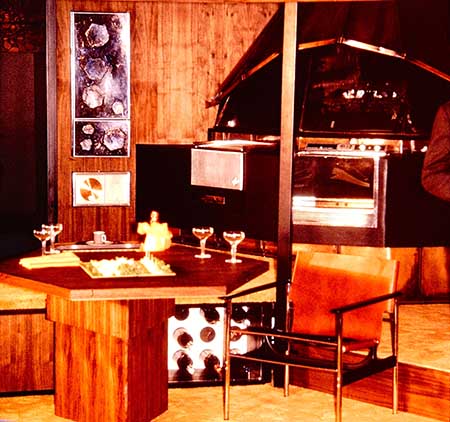
(In the Rogue’s Galley, all the art work covers an appliance. Note the wine-cooler and elegant lines. One of the models is a dead ringer for James Bond. Martini, anyone? All the pics are on Facebook).
Copyright 2014 Vic Socotra
www.vicsocotra.com
Twitter: @jayare303
Parnelli and Jim
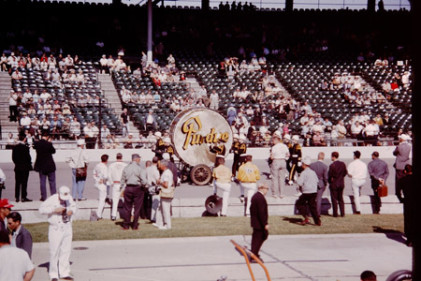
(The Purdue University Marching Band with their giant bass drum prepare to kick off the 1963 Indianapolis 500. Dad had a gang of like-minded car guys who would go to Indiana for the Race, and sometimes to the time trials that set the position on the grid. When he did not go in person, he would sit on the patio with the radio, graph paper and stopwatch and chart the race as it progressed.)
I had not thought about Parnelli Jones in a long time. I think he is still alive, some place.
Here is how he came to mind: I have had one of Raven’s plastic storage boxes with me since last week. I thought I might get to it during the week, but no soap. I threw it into the boot of the Panzer along with the laundry and got out of town under gray skies and temperatures that threatened to get above freezing for the first time in days. The roads were white with salt. The only traffic was around the big Fairfax Mall, where people could walk around unimpeded.
For a minute, anyway. The radio was bombarding me with news of the triple shooting at the Columbia Mall over in Maryland.
No one on the radio seemed to know much about it, though the reporting was breathless. When I hit the farm I turned the coverage off and switched over to classic alt rock on the satellite radio and let the news of the Imperial City fade away.
It faded so thoroughly that I got caught up in the events of 73 summers ago, interspersed with the graphic recollections of a race that marked the turn of technology a half-century ago.
OK- complex, I know. I bothered you with some articles about the surprise attack on Pearl Harbor this week. Old news, I know, but there are still some loose ends that cry out for tying up. I was on the phone for three hours as the late afternoon passed into darkness, and my porch dwarf became a beacon of light on the front porch, bravely holding his lantern against potential Zombie attack.
I will bore you with the topic of the conversation one of these days- it may mean a trip out to Pearl to ravel some of the raveled threads, and see about properly memorializing the place where our pal Mac Showers worked with the code-breakers in The Dungeon at the Naval Base HQ. The topic of the conversation was complex, and call was long, so I started feeding Kodak slides through the little yellow box that converts them to digital images as the call went on.
The first box of slides was unlabeled, and contained 36 slides. Like the trip Dad took to London and Brussels in 1968, this one had to tell me the story all by itself, no script. The time stamp on the back of each little cardboard square indicated the moment in history that they were developed, sliced and inserted into the cardboard squares: May, 1963.
JFK was President. The war in Vietnam was just a glimmer. There were cars and crowds in the images, and a vast speedway.
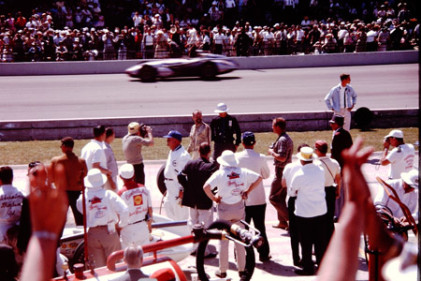
It was the Indy 500 Race, Memorial Day, 1963.
The spectacle was amazing- the crowd in their early ‘60s race finery. The front engine Offenhauser-powered cars were having their last hurrah. Parnelli Jones won the race, contested by the slim and elegant Scotsman Jim Clark in his rear-wheeled Lotus.
I have discovered I have a real knack for getting the slides scanned in backward, and having to do the scanning and digital manipulation over and over. Eventually, I got them all right as we hammered out a campaign that might- just might- get a suitable memorial to the crew that contributed so much to the defeat of Imperial Japan.
The more I looked at the images of the race, the more it came back as memories of Michigan transitioning from the late winter through the lens of Memorial Day, and the coverage of the race on the radio- WJR, I think, was the AM channel that had the voices and the roar of engines. If the weather was good (it wasn’t, always, Michigan being what it is) Dad would set up shop on the patio with a cooler of beer for the neighbor guys, and his tools of the trade: stop watch, graph paper and pencils of differing colors.

1963 was the last hurrah of the front-engined American iron at the brickyard. I could identify some of the cars: Parnelli (Rufus Parnell) Jones, the legendary race driver was going to win this one as the last gasp of the old technology.

Opposing him was the uber cool Jim Clark from Scotland in that amazing Lotus: rear engine, wide wheel base and European cool.
There was a controversy, too. Parnelli could not have been more old school, right out of the heart of the American Century and the Moonshine Express pantheon that spawned NASCAR. In 1962 he became the first driver to qualify for the race at a speed of over 150 miles an hour. He only won one race at the Brickyard as a driver, and 1963 was it.
I don’t know if you can sense the speed in the pictures- they are all on Facebook, if you care- but what is missing is the distinctive high-pitched roar of the engines. Here was the controversy that is not apparent from the pictures: Parnelli’s victory came despite the fact that he probably disqualified. Jim Clark and the Lotus were dogging his heels, and Parnelli’s car (Old 98, nicknamed “Calhoun”) hiccupped and began spewing oil from a broken tank. The film of oil on the track caused several drivers to spin out, either wildly into the infield or the abruptly into the wall.
Race officials put off black-flagging him after the 98-car’s owner J. C. Agajanian raced down Pit Lane and convinced them that the oil leak was below the level of a known crack and would not leak any further. Colin Chapman, the British owner of Clark’s Lotus accused the Indy officials of being biased towards the American driver and car.
Duh. There is no doubt in my mind that had it been an American driver and car in second place instead of Clark in the British-built Lotus, officials would have black flagged him.
The names came back, and the memories. Dad took me to one of the races- later than this one, and the images from that one may be lurking in the footlocker of Kodachrome moments.
The boxes are in no rhyme or reason, a jumble of disconnected events worth getting the camera out for, back in the time that capturing a photo meant being prepared for it.
Beyond the history of this particular race, I can give you little context. I know the little motel where the guys stayed, and the diner where the guys liked to eat after the trip from Detroit to Speedway, Indiana. But shorn of that, and the images of the Purdue Marching Band and the tank-like Chrysler pace car, these images stand in lonely isolation.
Thank God these images pre-date the invention of the video camera, in which we attempted to capture life in real time.
Hell, we don’t have time to live it fully even once, much less watch it over and over. So, for what it is worth, one afternoon in 1963, when the world looked a lot different than it does now.
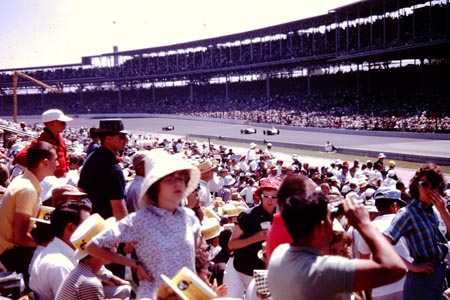
I kept feeding slides through the machine. I am not going to trouble you with the details of my 7th birthday party, Raven and Big Mama’s 1982 trip to Bermuda, the placid waters of Martin Lake, where the cabin was located, nor the amazing Playboy-style bachelor kitchen (“The Rogue’s Galley”) that was the flower of Dad’s styling shop at Kelvinator Appliances. Well, maybe I will.
But not today. Life threatens to go on.
Copyright 2013 Vic Socotra
www.vicsocotra.com
Twitter: @jayare303
What the Hell?
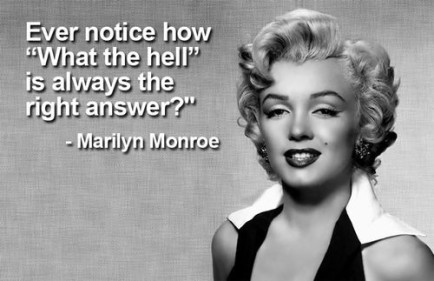
It was black when I got up and things didn’t get much better as the sky transitioned to a sort of depressing gun-metal gray. I went through the traffic and took the bad news like a man, whatever that is these days.
I saw the Market dropped yesterday, big time. The Dow plummeted nearly 320 points Friday, or almost 2% of its total value. It was the end of the worst week for stocks since November 2011. The S&P 500 slid more than 2.6%, logging its biggest weekly decline since May 2012.
Oh, hell, I thought. I know the market has been cruising for a correction. I mean, where the hell else are all those Bernanke Bucks going to go if interest at the bank is almost negative? So, naturally there is a bubble. I am getting quite peevish about it, though, since the smart guys have always taken their profit, sold short and left the rest of us chumps to take the losses.
I know I am not supposed to do it, but what the hell, and clicked over to look at the pathetic tally of assets on the broker’s website. I looked around some of the financial sites to find out why, and the Smart People were telling me that it was a perfectly rational correction, investors pulling back from damaged currencies in the emerging markets.
There was another school of thought represented in about equal measure. That is the one from the killjoys who say what is not sustainable is – well, you know. They think the emerging run on the banks in China is a symptom that the Potemkin Village of global finance is starting to crack.
I made a second pot of coffee, thinking that might be a luxury I would have to cut back on. I might rationally be looking at a single-wide trailer someplace where it is warm. My pals back in Michigan are starting to get a little hysterical about the arctic air, and the length of time until this winter is done. Someone reminded me that Global Cooling could mean a lot more intense storms, which is when the winds can pick up a trailer and take it straight to Oz, don’t pass go.

So, then I looked for properties that have old Cold War Bunkers on them. I have not done that since I was (briefly) in the bunker business after 9/11. There are a remarkable number of them from the days when perfectly rational people thought they were reasonable things to have. A tip, though: the old missile sites with the silos don’t have as much usable space in the tubes as you would like. My preference has always been for the hardened telecommunications sites, which were designed for rows and rows of comms racks.
An important note, though. If you need a bunker to get through what might, or might not be coming, would you want to be on the distant end of it?
http://www.missilebases.com/properties
Some do, apparently.

(This missile silo is actually for sale in upstate New York, with adjacent runway.)
I don’t know. I was still thinking about that when I wandered back to make the bed and get the place squared away so I can retreat to the farm and relax for a few days. I try to take whatever laundry needs to be done down with me, and after collecting the towels, gave a critical eye to the pillow-top mattress and the bright crimson sheets under the Ralph Lauren Oriental Rug pattern comforter.
I could wait to Spring, I know, but what the hell. I stripped the bed, balling up the sheets and pillowcases, and then performed the master stroke: I rotated the mattress.
Back in the old days, the manufacturers recommended the complete rotation periodically to keep the spine happy and prolong the life of the mattress. Obviously you can’t flip the pillow-top over- that would defeat the purpose. But I was comfortable that rotating the queen size bed 180-degrees was doing my bit for sustainability and progress.
It is better than having to rotate the filters on the underground air handling systems, you know?
Oh, An important note: more to yesterday’s ruminations about Pearl Harbor. Concerned associates reminded me of an excellent article from the archives of the Naval War College that suggests the extreme radio silence of the Kido Butai was part of an excellent denial and deception plan, and not a cover-up to protect the legacy of Franklin Roosevelt:
It is a great article, and one less conspiracy I have to worry about. Honestly, it is enough to drive you to a bunker some times!
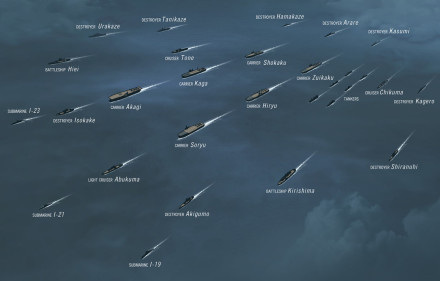
(The Kido Butai- the IJN Pearl Strike Group, as imagined by artist Joe Wight. Image courtesy of the artist).
Copyright 2014 Vic Socotra
www.vicsocotra.com
Twitter: @jayare303
Truth (and Consequences)
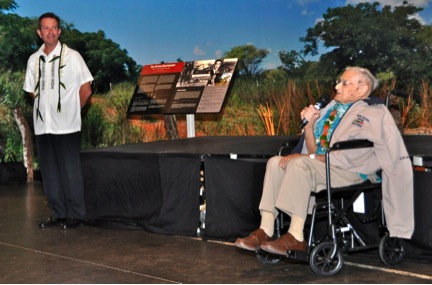
(Mac Showers speaks to an audience about the Battle of Midway at the 70th Anniversary in 2012. J2 RADM Paul Becker looks on. US Navy photo).
Snow still on the ground, temps still barely climbing to the double digits. I am going to Suitland for a military retirement this afternoon, though I would prefer to stay off the road and let the weekend wash over me like the broken water mains that are failing all over town.
Up North they are ready for this stuff. Here? Not so much.
I knew this was an uncommon event sitting at the apex of the Willow’s Amen Corner last night. Old Jim managed the trudge down the block, and Jon-without and TLB and the gang were there, all of us sharing some cabin fever. But when people came in and out of the double doors the icy blast reached right in and caressed my spine with frigid fingers.
When I got home I heated some protein and went through the accumulated messages. Two I had to flag for follow-up action when I was more articulate: one had an article about the fight the Vietnamese and the PRC had over the Paracel Islands in the waning days of the American War, and the successful effort of the Chinese to extend their sway by force.
Forty years ago, and here we are again, perhaps on the edge of armed conflict. The other message of note had the two articles attached to this missive. I thought about Mac, and how I wished I could just ask him what the truth was, and not have to worry about sorting it out myself.
Being a semi-literate Boswell to his Dr. Johnson was an honor, though his passing made our world a little smaller and less richly textured.
I opened them up and read both articles this morning over the first couple cups of dark-roasted Dazbog Russian while-bean coffee. This is not a homework assignment, and I include the files purely for your information. The struggle over the Truth is nicely addressed by both authors, and any information campaign large enough to cover a global war is obviously going to have some soft spots in it.
Considering the matter, I fell into a reverie of an afternoon- a warm afternoon- sitting next to the Admiral at Willow, asking him to walk me through the second Japanese attack on Pearl. It happened shortly after he arrived there and started to work at Station HYPO for legendary code-breaker Joe Rochefort.
Mac told the tale of “Operation K” with great vigor, and I was stunned that in all my reading about the attack and the aftermath, I had not noticed the event. The Japanese intended to spread a little terror in Hawaii with a night flight by two big Kawanishi H8K “Emily” flying boats. Looking through my notes on the bar napkins, I was amazed to find that it was the longest-range two-plane bombing sortie ever planned without fighter escort.
As things played out, Pearl was protected by clouds, and the Japanese flew blindly over Honolulu for a while before finally dumping their bombs near the Punchbowl. Irritation, not terror, was the result.
Mac said that Joe Rochefort blamed Jasper Holmes for that one, and it wa not entirely in jest. Jasper had been the author of thriller articles between the wars, and once published a fictional account of a Japanese seaplane attack on Pearl using seaplanes refueled by submarines while at anchor at French Frigate Shoals in the Saturday Evening Post.
The whole thing blew my mind. The first was that the Japanese did it at all was amazing, and then that men I regarded as heroes could play out their creative differences on the same staff. But people are people, regardless of what era in which they live.
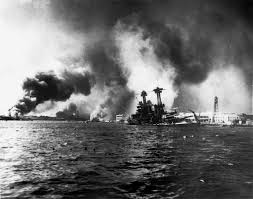
That is what intrigued me about the article by Eric Dahl, and the continuing controversy over who was responsible for the intelligence failure that sank the Pacific Fleet and killed thousands of sailors.
We have talked before about what Washington saw fit to tell Pearl Harbor, and one strand of intelligence was a series of near-daily messages from the Japanese Consulate in Honolulu back to Tokyo, informing Fleet HQ about which ships were at which anchorages in the harbor.
This stream of information was controlled by Richmond Kelly “Terrible” Turner in the Navy’s Office of War Plans. This became known as “The Bomb Plot” messages, using the Naval context of the term ‘plot’ as a map notation rather than some conspiracy. Although of course, it was that too.
It wa sa curious thing. Turner thought pacific Fleet commander Husband Kimmel had no need to know that the Japanese wanted precise locational information daily on his ships. That, in turn, played into the counterintelligence matter of whether there were Japanese spies on O’ahu. That would drive the response, which was the threat was not from Japanese warships, but rather from American citizens of Japanese extraction.
That the Consulate in fact had a HUMINT collector was a matter that was denied and then revealed by turns as the investigations- or witch hunts- continued after the attack itself, and after the war was concluded on terms favorable to the United States.
It all muddied the waters of warning and responsibility. I think clearly that Fleet Intelligence Officer Eddie Layton would have had a different perspective on what was coming, if he had known that Toyko was interested in a daily account of what fleet units were at which specific anchorages.
Admiral Nimitz appears prominently in the first article, as it attempts to compare and contrast the intelligence failure at Pearl, and the intelligence success at the battle of Midway that turned the tide.
Nimitz did not trust his intelligence officers blindly, and I talked with Mac about that many a time. The matter of radio silence by the Japanese Fleet in both attacks, and warning of their location is one that deals with what the system was able to read, what it was able to interpret, and how the information could be fused to present an actionable course to a gifted and bold commander.
Really, intelligence is nothing more than objective and classified journalism: the who, what, where and why of an effective story are precisely the same.
The article by Villa and Wilford argues something quite different, and gets to something I would like to ask Mac about right now. Their article speaks plainly to the fact that this is an information warfare puzzle about history itself. The attack on Pearl happened. Scapegoats had to be found. Kimmel and Short were the patsies. Note, if you will, the amazing amount of primary information that has strangely gone missing: the SS Lurline radio logs that might have proven the Japanese were coming, watch logs from HYPO, whole years of files from ONI vanished.
To me these curious missing documents suggest something else that was not explicit in the article. It is plain that someone was covering their ass, big time, and cleaning up the files to ensure that the story was what they wanted it to be when the shooting was done.
You recall the brilliant ruse to trick the Japanese into revealing the target- it happened at Mac’s desk in The Dungeon. Jasper Holmes came up with the idea to tell Midway Island via submarine cable (which the Japanese could not copy) to send an unclassified radio message that the water supply was becoming critical. Sure enough, the Japanese picked up the message and issued their own report that “AF” was short on water. That meant AF = Midway.
It actually was much more than a brilliant ruse to confirm that Midway was the target. Admiral Nimitz was interested in convincing Washington, not himself, about what the target might have been. DC was clearly an adversary in the intelligence picture.
And don’t forget that rogues and careerists were present in The Greatest Generation. I did not read the names of Richmond Kelly Turner, nor the Redman Brothers in the article, but I am convinced that the three of them were busy behind the scenes to ensure that the correct story was what history learned.
Factor in two important additional issues: national security in 1945 clearly meant that cryptologic triumphs (and failures) remained highly classified. So there is that, and then there are careers and reputations that needed to be protected.
The famous near-fist fight between ADM Turner and Mac’s boss Eddie Layton over ADM Kimmel’s guilt onboard the USS South Dakota the night before the formal surrender in Tokyo Bay is a case in point. Turner was drunk, and publically blaming Kimmel for something that he himself was actually culpable. The Radio Intelligence crowd had nearly four years to vacuum the official records between the first and second Congressional investigations of the attack on Pearl.
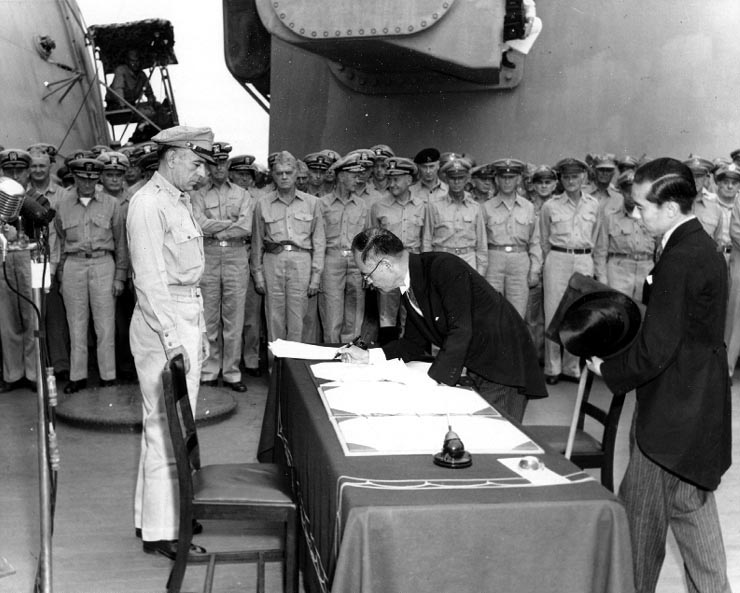
The issue of why primary source documents are still being withheld suggests that something else is going on in the accepted narrative, and that at a minimum a “perception management” effort was conducted to protect those whose errors in judgment lead directly to the disaster.
Was it FDR? I think it is more likely that it was the middle grade within the Radio Intelligence organization. But someone worked hard to ensure that when the time came that the past was to be examined, some of the critical information was long gone, and the great Traditional vs Revisionist history would go on until everyone who participated was in their graves.
And you know what? Almost all of them are. And we still don’t know the truth, though I think we have a pretty good idea of the consequences.
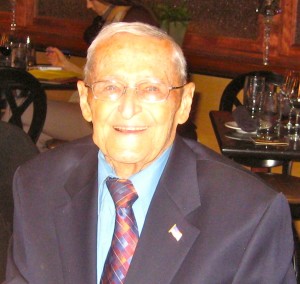
Copyright 2014 Vic Socotra
www.vicsocotra.com
Twitter: @jayare303Tru
Islands and Owls
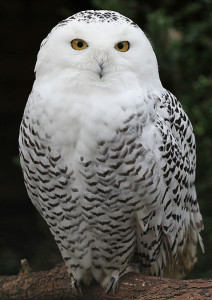
(Snowy owls- this one a female- are being spotted way outside traditional habitats. Which includes K Street in DC, of all places. Photo Wikipedia.).
We may get up to the twenties today, so I am officially bored with the weather. I got to thinking about the Hawaiian Islands yesterday, what with the birthdays, and a pal has returned to Key West from la Belle France late yesterday, and frankly, I would rather be warm than freezing my ass off up north, as famed island troubadour Michael McCloud puts it.
The white stuff is all still out there, of course. The temperature’s rise into the double digits this morning has not permitted anything to change. The snow and ice may be more compact, but it is still in the same state it was when it fell out of the sky.
A colleague wrote in amazement to say that there had been a sighting of a snowy atop a green awning at 15th and K streets NW near McPherson Square. According to the Washington Post- I had to be directed to the paper, since I no longer subscribe- the birds have now been sighted at such diverse places as “Revere Beach, MA, to Little Talbot Island State Park near Jacksonville, FL.
This is of note only because the snowy owls normally hang out in the treeless tundra of the Arctic. Considering the constant stream of stories about warming forcing some habitats north, and threatening mass extinction, it is good to know that the birds apparently have more sense than we do. They came south via the Great Lakes, Dakota Country and down to Arkansas.
I have not seen one down at the farm, but just before the snow came this week I was clearing some crap out of the garage and loading up on more of Raven’s old photo collection when I heard a tremendous clamor of honking. There is a flock of geese- a large one- that has set up shop on a pond on the property across the fence-line to the southwest.
Something got them going. The racket was loud enough that I put down the box of Kodak slides and walked over to see if the bird were advancing through the brush to attack the farm. Suddenly, the noise swelled and waves of the big gray and white birds appeared in ragged V-formation over the trees, wheeling majestically west, then south again.
I don’t know what it means. Predator on the ground, two or four legged? I waited to see if there would be gunshots, and there were not, so I got on with snow avoidance things. I was shutting down the farm to relocate back north ahead of the storm when something came up that wasn’t climate change, or Affordable Care or the other vaguely alarming issues that are getting the blogosphere all worked up every morning.
This one was just chilling. You know we are in the midst of a Pivot to the Pacific, right? I know, hard to tell where we are pivoting from moment to moment. But I have been following the developments in the South China Sea with bemused interest the last couple years.
In my time, the idea that the US Navy was not the preeminent power on the sea from San Diego to Tokyo and south to the Straits of Malacca and further west to the placid swells of the Indian Ocean was absurd.
Not so much any more. China’s rise has changed the calculus on everything. The new regional hegemon has asserted wild claims to virtually the whole South China Sea. It has purchased an old Soviet-era aircraft carrier. It has, in a word, deployed the force with which it intends to back up the claims of sovereignty. Like the snowy owls, they are way outside their normal habitat, yet seem unconcerned about the implications.
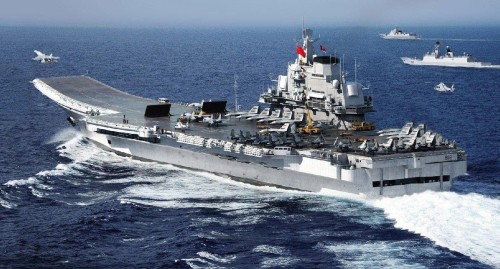
(Liaoning is a used aircraft carrier, but it is a cool one. This is her on sea trials. They say the Chinese are going to build another one from scratch).
All sorts of things are at issue. The Chinese assert claims to otherwise worthless rocks and shoals all the way to just off the shores of the Philippine Archipelago. And some insignificant flyspecks in the ocean between Taiwan, which the Mainland also claims, and Japan, which it doesn’t.
At least at the moment.
I don’t have time this morning to go into the blow-by-blow about the Senkaku Islands- as the Japanese term them. The Chinese call them the Diaoyus, and say that they are theirs alone. Suffice it to say that though the Japanese have administered the barren things since before the Second World War, the matter seems important to the Chinese, who have some issues about the way their people were murdered at Nanking seventy-odd years ago.
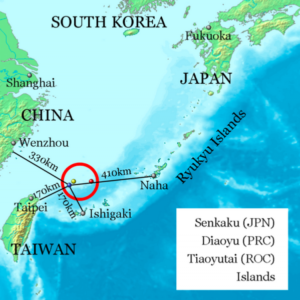
(The disputed Senkaku/Diaoyu Islands. Could the regional powers screw the pooch?)
Anyway, what caught my eye was not from one of the PRC Coast Guard Cutters which are buzzing around the islands, nor the imposition of a unilaterally declared Air Defense identification Zone (ADIZ) above them. The story was actually from Davos, Switzerland, where the really cool folks are gathered for the 2014 iteration of the World Economic Forum. The theme of this meeting, which is in progress, is “The Reshaping of the World: Consequences for Society, Politics and Business.”
I am wary enough about how we are reshaping the world. Wait, I need to re-phrase that. We are not re-shaping anything. We are the ones who are getting reshaped, and well and truly.
The word from Davos, relayed by a guy named Henry Blodget, was chilling.
I don’t know Mr. Blodget personally, nor do I anticipate ever getting asked to table with the financial elite of the world. I will take the words of the co-founder, CEO and Editor-In Chief of the magazine Business Insider, for what it is worth, which was free. Apparently he attended a dinner at the Forum in which a microphone was passed around the table so the attendees could articulate the issues that seemed the most significant to them.
He said when the mike got around to a prominent Chinese official, he opined that the biggest deal was the Diaoyus, and that the PRC just ought to take them back in a military occupation.
Blodget titled his account of the dinner “Someone Just Said Something About The Japan-China Conflict That Scared The Crap Out Of Everyone” which is just exactly what I was thinking.
The last time the Great Powers really screwed the pooch was a hundred years ago: 1914.
I don’t know if there are centennial tides in human affairs, or if there is just a hankering to imagine there is one. But the Japanese and the Chinese are having a moment not dissimilar to Shia and Sunni Muslims. They really don’t like each other, and there are some outstanding scores that they would both like to settle.
Gideon Rachman of the Financial Times tweeted the following about an interview with Shinzo Abe, the feisty Prime Minister of Japan:
Just interviewed Shinzo Abe @Davos. He said China and Japan now are in a “similar situation” to UK and Germany before 1914.”
— Gideon Rachman (@gideonrachman) January 22, 2014
I don’t know if the quote is accurate or not. But to the degree that the PM of Japan and highly ranked Chinese officials seem to concur, I have to agree with Mr. Blodget’s assessment. It is enough to scare the crap out of people.
I am no snowy owl, but I know when a habitat is about to change.
Copyright 2014 Vic Socotra
www.vicsocotra.com
Twitter: @jayare303
They Say It’s your Birthday
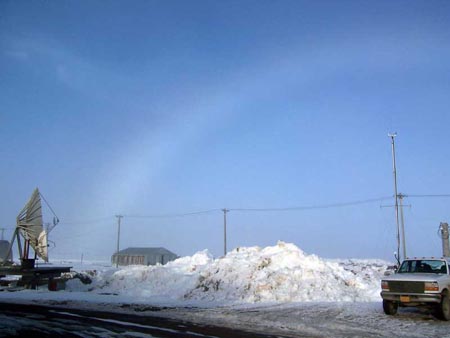
(Icebow at Barrow, AK, America’s northernmost city, north of the Arctic Circle and the same temperature as Blue Arlington this morning. Photo Wikipedia).
You say it’s your birthday
It’s my birthday too, yeah
They say it’s your birthday
We’re gonna have a good time
I’m glad it’s your birthday
Happy birthday to you.
Yes we’re going to a party party
Yes we’re going to a party party
Yes we’re going to a party party
– – Writers: John Winston Lennon and Paul James McCartney. Courtesy Sony/ATV Music Publishing
OK, OK. Weather is not climate. We all know that. The fact that the view from my window resembles Barrow, Alaska, the northernmost American city, is besides the point. Looking out the window of the apartment, the snow is blown into sculpted aerodynamic shapes across the pavement and the cars and the shrubs by the cutting wind. The wind chill spawned by the Polar Vortex this morning was fifteen below zero. The folks marching resolutely up the partially-cleared sidewalks and across the salted parking lot in the packed snow toward the Guard Bureau look exactly like Inupiat locals from Barrow.
Still, climate is the average of weather, over time, and these little incursions of pure cold dense arctic air are- well, breathtaking.
This morning, our temperatures were about the same between Barrow and Arlington, and I can safely say that we were both blue, though not for the usual reason.
I know this is not Alaska, and at some point the weather is going to get with the program and this stuff will melt. Hopefully Barrow won’t, at least not before it is High Summer north of the Circle, and we will just have to take the averages as they come. It does occur to me that we have had a temperature swing in the last day or so of almost 50 degrees, and despite some irritated squirrels and people, everyone is doing just fine.
When someone tells you that a couple hundredths of a degree of temperature difference is an impending catastrophe, well, I don’t know. Things have not gotten any warmer since 1998, according to the data-sets of the scientists. I am not completely certain the surface temperature can be accurately measured to that level of granularity anyway, given the tinkering with the historical record. Oh well, I am just going to bundle up and hope for warmth.
In the midst of growing cabin fever yesterday, I let my mind wander. I found that small measures of whiskey taken internally helped beat back the lassitude of enforced lassitude as the snow blew by the dining room window horizontally. I thought more about the gentle mauka winds and makai rainbows the color of shave ice, not ones made simply of ice.
I know precisely what I was doing 29 years ago today, and 31 years ago tomorrow. And I remember where. Biggest two days of my life- birthdays, in fact.
This was not supposed to be a birthday- that was not in the master plan. But one thing happened late in the afternoon, and that led to another thing, and then a short drive down the Nimitz Highway to the Queen’s Medical Center, founded by Queen Emma and King Kamehameha IV.
Then there we were, having a baby. Well, someone was. I was purely along for the ride, or rather just to do the driving and handle the bags. It was a curious thing- I remember the Doc looking up at the clock and it was approaching midnight. He asked if we wanted the kids to have the same birthday. We consulted briefly, and said “Heck, no! They ought to have their own!”
So, he worked a little faster, and our younger son was born just before the change of the day. There were many more adventures that shortly followed, but on this magical day, I was a father for the second time, and blessed to be.
The problem I had for a couple years after was that the younger son had the first birthday. Once I figured that one out, it was easy. The older boy was born on the 23rd of January, a Saturday, if I recall, and that was one for the ages. It was up in the pineapple fields of Wahiawa, not far from Field Station Kunia in central O’ahu.
I wrote down the details of both those events so I would never forget, and though the stories have been lost, the act of writing them seared the details into my brain. I will never forget a second of either one.
With those two birthdays, everything in my life changed. I have to say, these two days are about as good as it gets. All I have to remember is the younger is first, and the older is second.
And the smell of the flowers and the rich volcanic soil of the friendly islands. And what a miracle it all was. Twenty-nine years ago today. Thirty-one tomorrow.
Happy Birthdays!
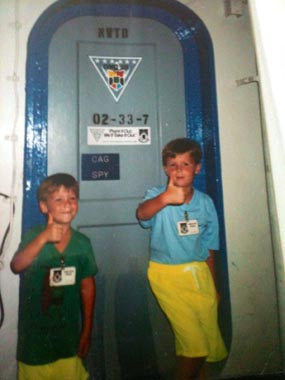
(The only things that actually meant anything in my life, posing onboard USS Forrestal (CV-59). Photo Socotra).
Copyright 2014 Vic Socotra
www.vicsocotra.com
Twitter: @jayare303
